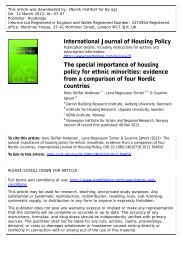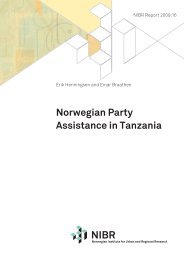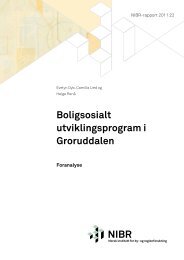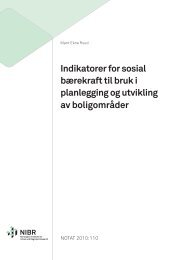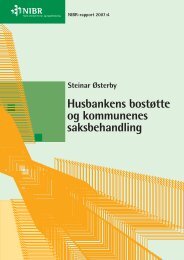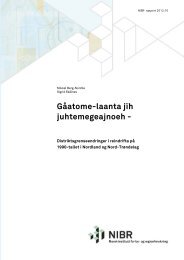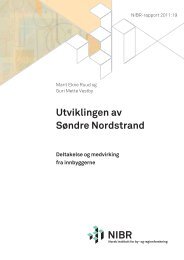Kunnskap og åpenhet om psykisk helse og psykiske lidelser
1706 NIBR folder 170/240.qxd - Norsk institutt for by- og ...
1706 NIBR folder 170/240.qxd - Norsk institutt for by- og ...
- No tags were found...
Create successful ePaper yourself
Turn your PDF publications into a flip-book with our unique Google optimized e-Paper software.
11Relational proximity, as dealt with in this project, refers to actualrelationships between family members, between friends and betweencolleagues. The closer the relationship, the more people are willing tospeak frankly about mental health issues, and vice versa. Anotherform of relatedness c<strong>om</strong>es into play when we ask people to identifywho they feel are in need of better mental health. And the trend isrelatively clear on this question. The greater the relational distance,the more likely people will believe that others’ mental health is underpar, and the closer the relationship, the less likely that assumption willobtain. A great many people feel that the mental health of thepopulation at large is under par, fewer feel this applies to their friends,and fewer still to their own mental health. There appears to be an ideathat the population’s mental health is worse than one’s friends, andthat their mental health in turn is poorer than one’s own. At the sametime, few people feel they could do anything to improve the mentalhealth of the nation, more feel they might be able to help their friendsand most feel they can help themselves.The findings also show that experiences of psychol<strong>og</strong>ical disorders isquite widespread. Nearly 75 per cent say that s<strong>om</strong>ebody they knowwell has suffered fr<strong>om</strong> s<strong>om</strong>e psychol<strong>og</strong>ical disorder in the past threeyears. Many people are therefore affected in s<strong>om</strong>e way in this area.About half of our interviewees say that they themselves have hadoccasion to obtain information on mental health issues. Most peoplefeel their doctor would the most obvious person to approach, though asmall minority say that psychol<strong>og</strong>ist or psychiatrist would be asviable. Apart fr<strong>om</strong> the over-fifties age group, the Internet serves as apopular information channel. Most of the other possible sources ofinformation are considerably less popular.With regard to actual knowledge, the study shows that most peopleassociate psychiatric disorders with depression or depressive reactions,anxiety, schizophrenia and manic-depressive disorders. Only aminority say they know in detail what the various designationsactually entail, however.The report also analyses the opinions and attitudes to mental healthand psychiatric disorders. Thirty-two questions covering a wide rangeof issues were put to the interviewees. Findings are presented in statement-responsecategories (Chapter 6), and are analysed to see if theopinions expressed could be used as indicators of attitudes topsychiatric disorders (Chapter 7).Responses to the statements are presented in the following sequence:general opinions c<strong>om</strong>e given first, followed by opinions concerningNIBR-rapport 2003:5



